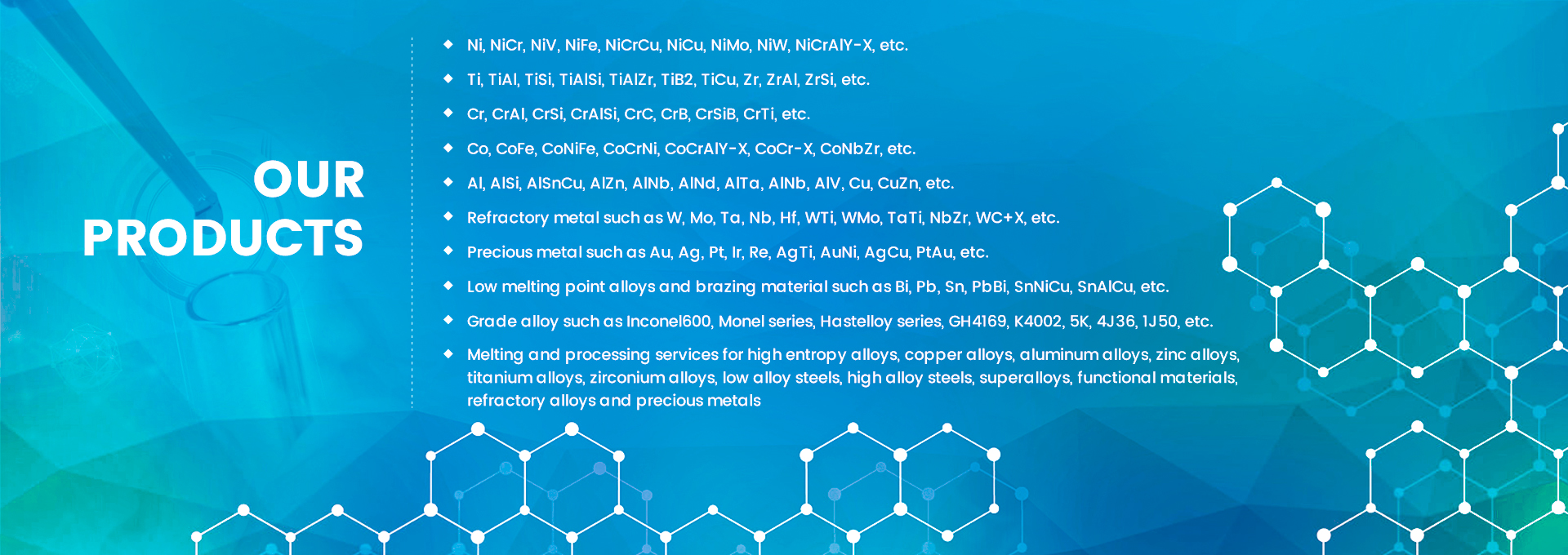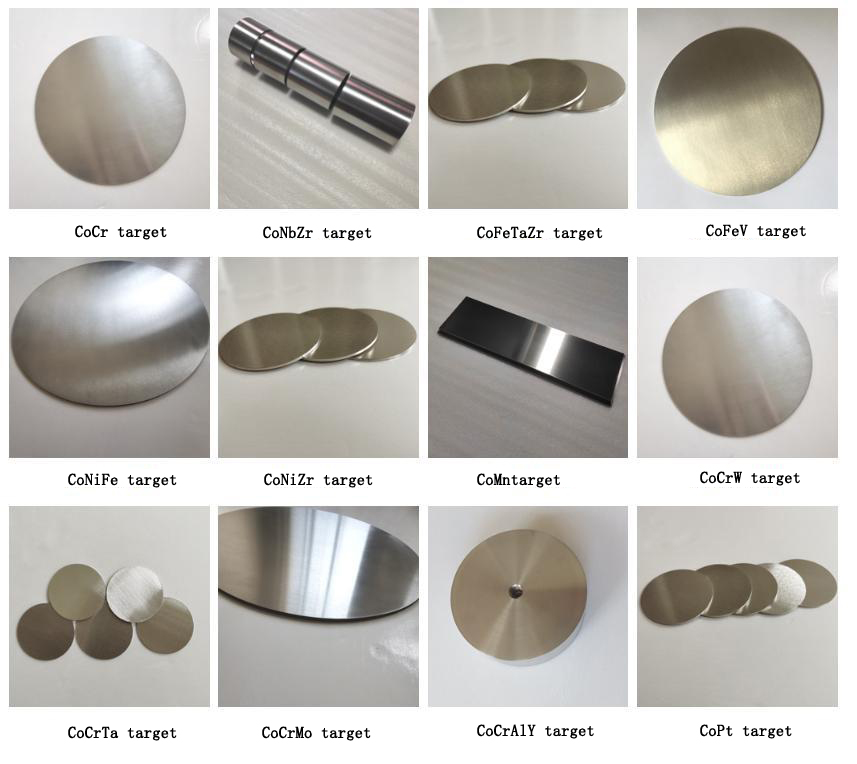Cobalt and cobalt alloy targets are indispensable functional materials in modern industry, It is widely used in physical vapor deposition (PVD) technology. With their excellent physical and chemical properties, cobalt targets and their alloy counterparts play a crucial role in fields such as electronics, optics, aerospace, and medical devices. This article will provide a detailed introduction to the composition, properties, and applications of cobalt targets and various cobalt alloy targets.
1. Cobalt Sputtering Target
Composition: Pure cobalt (Co)
Properties: Cobalt has a high melting point (1495°C), excellent wear resistance, corrosion resistance, and good magnetic properties.
Applications: Cobalt targets are primarily used in the preparation of magnetic thin films, semiconductor devices, and highly corrosion-resistant coatings.
2. Cobalt Chromium Target (CoCr sputtering target)
Composition: Alloy of cobalt (Co) and chromium (Cr)
Properties: Cobalt-chromium alloys exhibit high hardness, excellent wear and corrosion resistance, and good biocompatibility.
Applications: Widely used in medical devices (e.g., artificial joints), aerospace components, and wear-resistant coatings.
3. Cobalt Niobium Zirconium Alloy Target (CoNbZr target)
Composition: Cobalt (Co), niobium (Nb), zirconium (Zr)
Properties: This alloy offers high strength, high heat resistance, and excellent oxidation resistance.
Applications: Used in high-temperature alloy coatings, nuclear industry components, and high-performance materials in aerospace.
4. Cobalt Niobium Iron Zirconium Alloy Target (CoNbFeZr alloy target)
Composition: Cobalt (Co), niobium (Nb), iron (Fe), zirconium (Zr)
Properties: Combines high strength, high toughness, and excellent corrosion resistance.
Applications: Suitable for nuclear reactor components, high-temperature alloys, and corrosion-resistant coatings.
5. Cobalt Iron Vanadium Alloy Target (CoFeV Thin film target)
Composition: Cobalt (Co), iron (Fe), vanadium (V)
Properties: Exhibits excellent magnetic properties and mechanical strength.
Applications: Used in magnetic thin films, sensors, and high-performance magnetic materials.
6. Cobalt-Nickel-Iron Alloy Target (CoNiFe)
Composition: Cobalt (Co), nickel (Ni), iron (Fe)
Properties: This alloy has high magnetic permeability, low coercivity, and good thermal stability.
Applications: Widely used in magnetic storage devices, sensors, and electromagnetic shielding materials.
7. Cobalt Manganese Alloy Target (CoMn sputtering target)
Composition: Cobalt (Co), manganese (Mn)
Properties: Offers excellent magnetic properties and oxidation resistance.
Applications: Used in magnetic thin films, battery electrode materials, and catalysts.
8. Cobalt Chromium Tungsten Alloy Target(CoCrW)
Composition: Cobalt (Co), chromium (Cr), tungsten (W)
Properties: Features high hardness, excellent wear resistance, and superior high-temperature performance.
Applications: Suitable for aircraft engine components, cutting tools, and wear-resistant coatings.
9. Cobalt-Chromium-Tantalum Alloy Target (CoCrTa)
Composition: Cobalt (Co), chromium (Cr), tantalum (Ta)
Properties: This alloy has high corrosion resistance, high strength, and good biocompatibility.
Applications: Used in medical devices, aerospace components, and corrosion-resistant coatings.
10. Cobalt-Chromium-Molybdenum Alloy Target (CoCrMo)
Composition: Cobalt (Co), chromium (Cr), molybdenum (Mo)
Properties: Exhibits high hardness, excellent wear resistance, and superior corrosion resistance.
Applications: Widely used in artificial joints, cutting tools, and high-performance coatings.
11. Cobalt-Chromium-Aluminum-Yttrium Alloy Target (CoCrAlY)
Composition: Cobalt (Co), chromium (Cr), aluminum (Al), yttrium (Y)
Properties: This alloy offers excellent oxidation resistance, high-temperature performance, and thermal shock resistance.
Applications: Used in aircraft engine coatings, high-temperature alloys, and heat-resistant materials.
12. Cobalt-Platinum Alloy Target (CoPt)
Composition: Cobalt (Co), platinum (Pt)
Properties: Features high magnetic properties, corrosion resistance, and good chemical stability.
Applications: Used in magnetic thin films, high-end electronic devices, and catalysts.
Conclusion
Cobalt and cobalt alloy targets hold a significant position in modern industry due to their diverse compositions and excellent properties. By adjusting the ratio of cobalt to other elements (such as chromium, niobium, zirconium, iron, vanadium, nickel, manganese, tungsten, tantalum, molybdenum, aluminum, yttrium, and platinum), their properties can be optimized for different application fields. For example, cobalt-chromium alloys are widely used in medical devices due to their excellent biocompatibility; in aerospace, cobalt-niobium-zirconium and cobalt-chromium-aluminum-yttrium alloys are ideal choices for their high-temperature and oxidation resistance; and in electronic devices, cobalt-platinum and cobalt-nickel-iron alloys play key roles due to their superior magnetic properties.
With technological advancements, the design and optimization of cobalt alloy target compositions will continue to drive innovation and application in high-end manufacturing. Whether in wear-resistant coatings, magnetic thin films, high-temperature alloys, or corrosion-resistant materials, cobalt and cobalt alloy targets demonstrate broad application prospects and immense development potential.
Post time: Apr-16-2025






